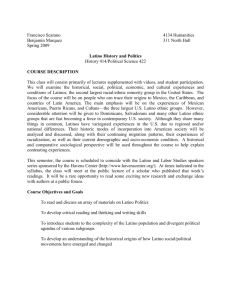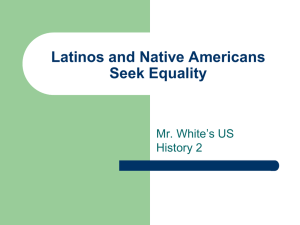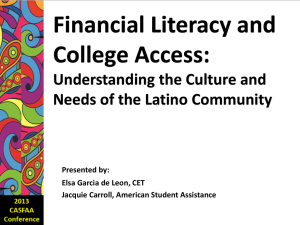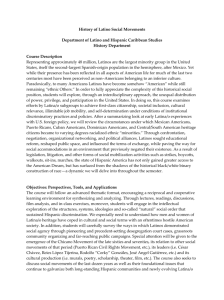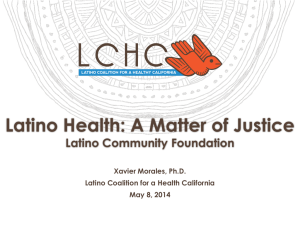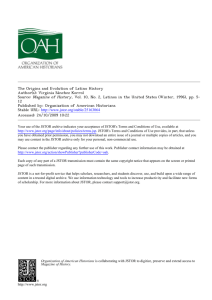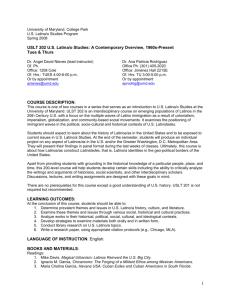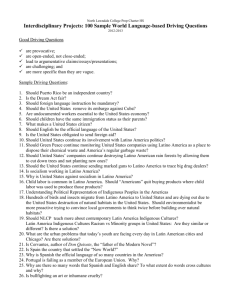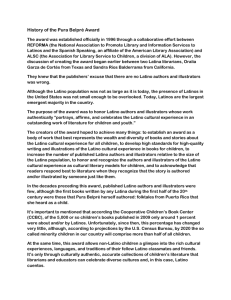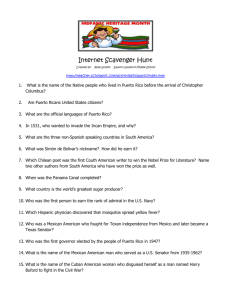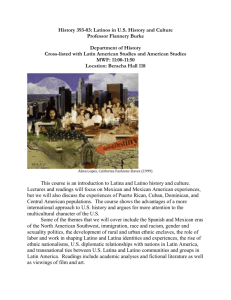Excerpted from : “Demanding their Rights: The Latino Struggle for
advertisement
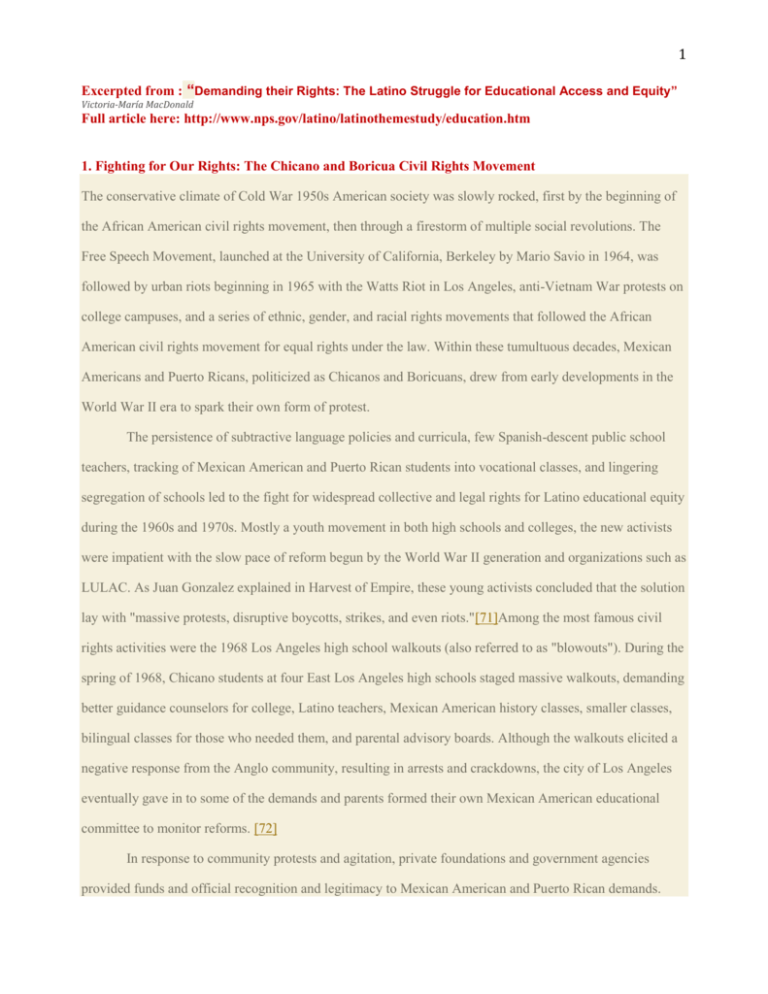
1 Excerpted from : “Demanding their Rights: The Latino Struggle for Educational Access and Equity” Victoria-María MacDonald Full article here: http://www.nps.gov/latino/latinothemestudy/education.htm 1. Fighting for Our Rights: The Chicano and Boricua Civil Rights Movement The conservative climate of Cold War 1950s American society was slowly rocked, first by the beginning of the African American civil rights movement, then through a firestorm of multiple social revolutions. The Free Speech Movement, launched at the University of California, Berkeley by Mario Savio in 1964, was followed by urban riots beginning in 1965 with the Watts Riot in Los Angeles, anti-Vietnam War protests on college campuses, and a series of ethnic, gender, and racial rights movements that followed the African American civil rights movement for equal rights under the law. Within these tumultuous decades, Mexican Americans and Puerto Ricans, politicized as Chicanos and Boricuans, drew from early developments in the World War II era to spark their own form of protest. The persistence of subtractive language policies and curricula, few Spanish-descent public school teachers, tracking of Mexican American and Puerto Rican students into vocational classes, and lingering segregation of schools led to the fight for widespread collective and legal rights for Latino educational equity during the 1960s and 1970s. Mostly a youth movement in both high schools and colleges, the new activists were impatient with the slow pace of reform begun by the World War II generation and organizations such as LULAC. As Juan Gonzalez explained in Harvest of Empire, these young activists concluded that the solution lay with "massive protests, disruptive boycotts, strikes, and even riots."[71]Among the most famous civil rights activities were the 1968 Los Angeles high school walkouts (also referred to as "blowouts"). During the spring of 1968, Chicano students at four East Los Angeles high schools staged massive walkouts, demanding better guidance counselors for college, Latino teachers, Mexican American history classes, smaller classes, bilingual classes for those who needed them, and parental advisory boards. Although the walkouts elicited a negative response from the Anglo community, resulting in arrests and crackdowns, the city of Los Angeles eventually gave in to some of the demands and parents formed their own Mexican American educational committee to monitor reforms. [72] In response to community protests and agitation, private foundations and government agencies provided funds and official recognition and legitimacy to Mexican American and Puerto Rican demands. 2 One of the broadest and most symbolic improvements was federal recognition of Mexican Americans as an identifiable ethnic group. With the election of Texan Lyndon B. Johnson to the U.S. Senate and his rise to the presidency after President John F. Kennedy's tragic assassination, Mexican Americans hoped that their needs would be recognized along with African Americans under the many programs created for both the War on Poverty and Afirmative Action.[73]An early significant piece of legislation was the U.S. Congress' passage in 1968 of the Bilingual Education Act (BEA), the first piece of federal legislation that recognized the needs of Limited English Speaking Ability students. Intially participation in BEA by school districts was voluntary. With the 1974 U.S. Supreme Court case, Lau v. Nichols, however, the provision of educational services for English Language Learners, of any nationality or ethnic background, was mandated.[74] While the level of federal recognition was initially slow, Latinos were able to garner political power through electoral means. The Mexican American Legal Defense Education Fun (MALDEF) was created in 1968 with the assistance of the NAACP and funding from the Ford Foundation. Similarly, the Puerto Rican Legal Defense Education Fund (PRLDF) was created in 1972 and centralized community activists, providing more resources and funds to hire lawyers and file lawsuits against schools and other institutions that were denying Latinos equitable educational opportunities. The U.S. Supreme Court first recognized Mexican Americans as an identifiable ethnic group in Hernandez v. Texas (1954). Significantly, before Mexican Americans could seek relief against discrimination in court, Hernandez affirmed that the Fourteenth Amendment extended "beyond the racial classes of white or negro."[75]This ruling opened the way for Cisneros v. Corpus Christi (TX) Independent School District (1970). As historian Guadalupe San Miguel, Jr. pointed out, when school districts attempted to utilize Latino children to achieve racial balance in Black schools, the original strategy of Mexican American lawyers classify students as "white" finally backfired.[76]In Cisneros, the judge ruled that Mexican Americans were "an identifiable ethnic minority group," and could thus benefit from Brown v. Board of Education school desegregation cases. In a subsequent ruling, Keyes v. School District Number One, Denver, Colorado (1973), the U.S. Supreme Court stated that Mexican Americans had the constitutional right to be recognized as a separate minority. The work of Chicano activists in the Southwest had a parallel among Puerto Rican leaders in the Northeast and the urban Midwest. Building on the work of pre-1960 3 groups such as the Puerto Rican-Hispanic Leadership Fund (1957), community-based organizations such as the United Bronx Parents, Inc. (1965) pushed for bilingual schools and teachers. The outcome of the civil rights movement among Puerto Ricans and Chicanos affected most areas of society, including higher education. One tangible result was the creation of Chicano and Puerto Rican studies and research centers on college campuses. Scholars organized to ensure that social science research on Latinos was included in traditional research agendas and that more Mexican, Puerto Rican, and other Spanish-descent faculty were hired.[77]The Latino experience is now a legitimate field of study and there are academic journals, courses, and university departments devoted to research on Latino history and culture. The Ethnic Studies Department (encompassing African/Native American/Asian and Raza Studies) at San Francisco State University is generally considered the first such entity in higher education history, established in 1969.[78]Before 1970, the number of Latino youth entering college was disproportionately smaller than that of white or African American youth.[79]Latinos took advantage of greater access to higher education during the 1970s, pouring into community colleges, state universities, and Ivy League campuses. The first generation of Chicano and Puerto Rican Ph.D. scholars entered the academic field in the early 1970s, teaching Mexican American and Puerto Rican history classes and writing books from a culturally specific perspective.[80]The number of Latino faculty at the nation's universities remained small at the turn of the 21st century (less than four percent), but should increase as new generations of Ph.D. students matriculate and enter the academy. 2. Post-Civil Rights to the Present In the post-Civil Rights era, Latinos have had to maintain vigilance to avoid a rollback of the hard won advances of the 1960s and 1970s. At least two broad factors have negatively affected educational progress for Latinos in the post-1980 era, although none have brought Latinos back to a pre-1970 level. First, the 1965 Immigration and Nationality Act (Hart-Cellar Act) which removed national origin numerical quotas in place since the 1920s and favored reunification of family members and workers with needed skills, led to the second largest wave of immigration to the U.S., particularly of persons from Latin America and Asia. Second, after decades of liberal reforms, economic and political pressures ushered in a new wave of conservatism in the U.S., represented by the election of President Ronald Reagan for two terms from 1981 to 4 1989. Under the Reagan Administration, severe cuts in taxes and government agencies resulted in reduced support for student grants, among other beneficial programs, and the number of Latino students in college began to level off after years of gains in the 1960s and 1970s. These two macro societal shifts, coupled with economic stagnation and debt from the long Vietnam War, resulted in negative repercussions towards Latinos, whether new arrivals or long time descendents of Spaniards. In Miami, Florida, angry individuals fought against the federal government's decision in 1980 (under President Jimmy Carter) to permit additional Cuban refugees, "Marielitos," to enter the U.S. Approximately 125,000 Marielitos were allowed to enter. Distinct educationally, socially, and economically from the earlier "Golden Wave" of Cuban exiles admitted during the height of the Cold War, the new refugees were viewed as inferior, possessing few skills, and possibly criminals or mentally ill. Latinos also experienced forms of backlash through English-Only movements, which sprang up at the local, state, and federal levels throughout the country. For instance, in 1983 Senator S.I. Hayakawa of California formed an organization called U.S. English calling for English to be the official language of the country. In other forums, non-Hispanic individuals and groups argued that bilingual education programs were merely employment agencies for Latino teachers and launched other accusations based upon nativist sentiments rather than documented information. In Texas, the state's attempt to pass legislation which would deny public school entrance to undocumented children was successfully challenged and stopped by the U.S. Supreme Court in 457 U.S. 202 (1982). As of 2012, Plyler v. Doe remains the law of the land, despite recent efforts in several states to challenge the Supreme Court case. As the number of Latinos grew dramatically between the 1990 and 2010 censuses, not only in historically familiar states, but also into the American South, the Far West, and the Mid-Atlantic, antiimmigrant groups fueling nativist rhetoric passed exclusionary legislation. Voters in 1990s California, for example, eradicated bilingual education in the state and also voted for measures requiring teachers to report students whom they believed were undocumented to federal immigration authorities.[81]Latinos responded to these measures with several counter efforts learned through a long history of demanding their rights. Communities marched in rallies during the 1990s and early 2000s, asserting their rights as citizens in a democracy to be in this country, have their children receive English language services without denigrating 5 home languages, and resist marginalization at all levels of school and university systems. Organizations such as MALDEF and the National Council of La Raza, in existence since the 1960s, were able to quickly file lawsuits against discriminatory legislation. In newer areas of the country, Salvadoran immigrants in the Washington, D.C. area founded advocacy organizations such as Casa de Maryland in 1985. In a parallel move, organizations that had previously identified with only one Latino sub-group, such as the Puerto Rican Legal Defense Education Association (now LatinoJusticePRLDEF) have changed their names and orientation to be more inclusive of all Latinos and also leverage collective action. The latest challenge to educational opportunities and access for youth resides in the phenomenon of children brought to the U.S. as babies or young children who remain undocumented. As they reach high school age, and discover that they are not documented, they see little future for themselves and are at risk for deportation along with their undocumented parents. In order to offer hope and opportunities for these children, the Development, Relief, and Education of Alien Minors (DREAM) Act was introduced in the U.S. Senate in 2001. The DREAM Act would allow these minors to enroll in college or enlist in the military and have a pathway to permanent residency. In most states, the DREAM Act also permits undocumented students to pay in-state vs. international student tuition, a significant savings. The requirements for the DREAM Act are lengthy and strict. Currently (as of 2012) 13 states have passed their own forms of the DREAM Act, but the U.S. Congress has failed to pass the bill despite attempts since 2001. From the earliest days of their arrival in the Americas' "Anglos, Mexicans, Puerto Ricans, Cubans, and other members of the Latin American diaspora" have placed a high value upon education as a means of economic, political, social maintenance, and upward mobility. Equitable opportunities and access to quality educational facilities have posed a formidable challenge to Latinos throughout U.S. history. The Latino community has displayed persistence, courage, sacrifice, and heterogeneity in its response to discrimination. Whether the issue concerns undocumented students' ability to receive in-state college tuition, if Spanish can be utilized in the schools without punishment, or resisting the eradication of Mexican American history courses (such as has recently happened in Tucson, Arizona), Latino communities have never taken for granted their constitutional rights. Through collective action, lawsuits, lobbying, petitions, and other 6 measures, they have not remained silent, but reminded the U.S. that all of its citizens, not only a select few, must be a part of the polity in order for a healthy democracy to function. Victoria-María MacDonald, Ed.D., is Unit Chair and Assistant Professor of Minority & Urban Education at the University of Maryland, College Park. Her research examines how historical legacies impact policy, access, and equity for contemporary Latino and African American students. MacDonald is the author of numerous works including Latino Education in the United States: A Narrated History, 1513-2000 (2004). Her latest article (with student Benjamin P. Hoffman) is "Compromising La Causa?: The Ford Foundation and Chicano Intellectual Nationalism in the Creation of Chicano History, 1963-1977" in History of Education Quarterly (May 2012). She received her B.A. in History with honors from Wellesley College and Ed.M. and Ed.D. degrees from Harvard University. A Spencer postdoctoral fellowship from the National Academy of Education supported her research on Latino educational history.
